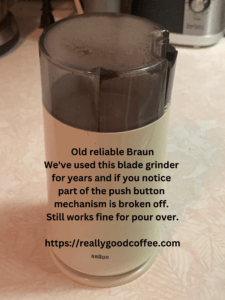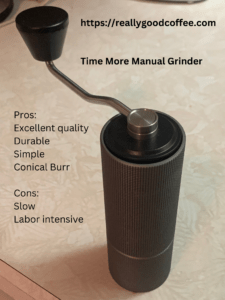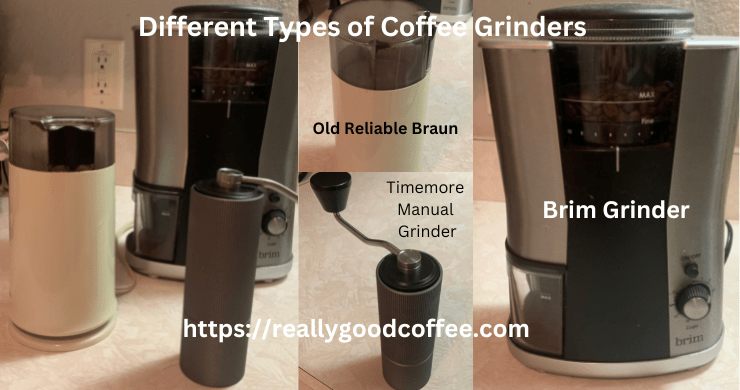You’re on vacation. You just checked into that pristine, near-perfect Airbnb. You’re looking forward to enjoying yourself. You start looking around and checking out the appliances. “This place has everything I need!” you say. As you’re getting unpacked you place your pound of freshly roasted coffee beans on the counter next to the French press provided by the host.
You wind down and go to bed.
You wake up in the morning. “Alright! Time to get some coffee brewing!” But lo and behold, a grinder is nowhere to be found. What are you going to do? You’re in the middle of nowhere and the closest store is 30 minutes away. They might not even carry a coffee grinder. You begin to improvise. You find a blender in the corner cupboard. “Can this work as a grinder?”
Reasons for Grinding Your Own Coffee Beans
There are many reasons for grinding your own coffee beans:
- Grind size: It allows you to have control over the grind size. This is important because the grind size will affect the flavor of the coffee. A finer grind will result in a stronger cup of coffee, while a coarse grind will produce a weaker cup of coffee.
- Fresher Coffee: Grinding your own beans allows you to create more aromatic coffee. Coffee beans begin to lose their flavor as soon as they are ground, so pre-ground coffee can be quite stale by the time you drink it.
- Satisfaction: It’s simply more satisfying to drink coffee made from beans that you’ve ground yourself!
- Flavor: It tastes better.
Grind Settings for Coffee Beans
When you grind coffee beans, you set the grind the beans to match the brewing method.
Grinding beans allows for exposing more surface area of the coffee to the water you are brewing it in. You adjust the grind according to which brewing method you are using as well as how long the ground beans are exposed to the water during the brewing process.
The grind settings on a coffee grinder are important because they determine how finely or coarsely the beans will be ground. The wrong grind setting can ruin a cup of coffee, so it’s important to know what you’re doing.
There are three main grind settings for coffee beans: coarse, medium, and fine. The grind you choose will depend on your brewing method and personal preferences.
Coarse: This is the most common grind setting for French press and cold brew coffee. The large, chunky pieces of coffee take longer to extract, resulting in a bolder flavor.
Medium: Medium grinds are often used for pour over and drip coffee makers. The medium-sized pieces of coffee allow for a more even extraction, resulting in a well-rounded flavor.
Fine: Finely ground coffee is typically used for espresso. The small pieces of coffee extract quickly, giving the espresso its signature strong flavor.
Extra-fine: Extra-finely ground coffee is sometimes used for Turkish coffee. The extremely fine grind results in a very strong cup of coffee.
How to Determine the Right Grind Size for Your Coffee Maker
The grind size you choose will depend on the type of coffee maker you’re using. Here’s a quick guide to help you choose the right grind setting for your coffee maker:
- French press or cold brew coffee maker: coarse
- Pour over or drip coffee maker: medium
- Espresso machine: fine
- Turkish coffee pot: extra-fine
Note that these are just general guidelines. You may need to experiment with different grind sizes to find the one that works best for your particular coffee maker and brewing method.
Storing Ground Coffee
Once your coffee beans are ground, it’s important to store them in an airtight container to keep them fresh for longer. Ground coffee generally has a shelf life of about two weeks, so be sure to use it up within that time frame for the best flavor. You can store ground coffee in the freezer for up to six months, but it’s best to grind only the amount you need for each batch of coffee.
Can a Blender Be Used as a Grinder?
The short answer as to whether or not you can grind your coffee in a blender. Sort of but not really…
Yes, you can grind your coffee in a blender, and it’ll work in a pinch. But for serious coffee drinkers or even for those who enjoy a quality brew, a blender is not a good long-term solution. But let’s take a closer look at what grinding coffee beans in a blender does.
Grinding Beans in a Blender 101
The rotating blades at the bottom of the blender pitcher do the hard work of grinding. In this sense, this is similar to a blade coffee grinder. The main difference is that in a blender you have much more room to grind coffee. This is a weakness of many household blade grinders—they don’t have enough volume.
If you want to grind enough coffee for an entire pot, you may be going through a grinding cycle two to three times. Of course, this all depends upon your desired brew strength.
That being said, if you have a blender and like to grind coffee in large quantities, this may be the right fit for you, especially if you are accustomed to using a blade grinder anyhow. A blender can actually grind your coffee at a greater consistency than a tiny blade coffee grinder.
If you don’t mind pre-ground coffee, then you can avoid the hassle of pulling out the blender. However, if freshly ground coffee is important to you, then the blender can get the job done. Just know that the consistency is not going to be the same as pre-ground coffee that you can buy in a grocery store.
Is a burr grinder better than a blade grinder?

Old Reliable Braun blade grinder
The short answer is yes.
If you haven’t heard of a burr grinder, it’s time you have. They come electric and manual. This is the best way to get a consistent grind for your morning brew.
Blade grinders chop the beans into specific ground sizes based on the length of time that the beans are ground. This is adequate for drip and pour over, but not espresso.
But a burr grinder grinds the beans against a burr so that you have better control. Burr grinders actually “pulverize the beans” rather than chop them.
This results overall in a more consistent grind. Your grounds of coffee will roughly be the same size.
There are two different types of burr grinders. Wheel grinders have a burr that spins like a wheel. The speed is usually faster. They are messier and louder. They’re also better for your wallet.

Time More Manual Burr Grinder
Then there’s the conical burr. These are the best burr grinders on the market. It’s because they are so thorough and spin slower than the wheel grinder that they grind coffee less quickly. But if you enjoy the most consistently ground cup of coffee, this is your machine. It will pay you back in smooth and flavorful coffee to drink.
What is the best way to grind coffee beans without a grinder?
If you don’t have a coffee grinder, you can use a food processor or blender to grind your coffee beans. Just add the desired amount of beans to the food processor or blender and pulse until they’re ground to your desired consistency. You might need to experiment with different pulsing times to get the right grind for your coffee maker. Keep in mind that grinding coffee beans in a food processor or blender will likely be noisier than using a coffee grinder.
Can you grind whole coffee beans in a food processor?
You can grind whole coffee beans in a food processor, but the results will not be as good as if you use a dedicated coffee grinder. The blades on a food processor are not as sharp as the blades on a coffee grinder, and they are also not designed to grind beans into a fine powder. It will work but it’s like using a blunt object to cut a steak. It will get the job done but it’s not the best approach to coffee.
The biggest problem is controlling a consistent size of the finished grind.

Leave a Reply